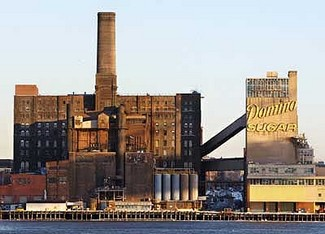Council restored office tower’s height cut by the City Planning Commission. On June 30, 2010, the City Council’s Land Use Committee approved a modified version of CPC Resources Inc.’s proposal to build a mixed-use project at the Domino Sugar plant site along Williamsburg’s East River waterfront. The project site includes the plant’s 9.8-acre waterfront parcel north of the Williamsburg Bridge and south of Grand Ferry Park, and a 1.3-acre upland parcel across Kent Avenue between South 3rd and 4th Streets.
The original proposal included converting the landmarked Domino Refinery Building into market-rate housing, building four towers on the waterfront parcel, and developing a fifth building on the upland site. Each of the towers would include low-, mid-, and high-rise components. CPC Resources planned to build two towers on the northern and southern edges of the waterfront site that would reach 30 stories along the river, two centrally located 40- story towers, and a fourteen-story building on the upland site. The project would have provided 2,200 residential units, including 660 affordable units; 125,000 sq.ft. of ground floor retail; 99,000 sq.ft. of office space primarily located in the northern tower; four acres of public waterfront; and 1,600 underground parking spaces located Elliottin four separate facilities.
At the City Planning Commission’s April 28 hearing, elected officials and residents divided on the proposal. Among the supporters, Council Member Diana Reyna said the project would create housing for low-income residents who have been displaced by a recent surge in market-rate housing development. Opponents of the project included local Council Member Stephen Levin, who testified that the project was too dense for the neighborhood’s infrastructure. Levin said the developer should only build a 1,600- unit project, but should still provide 660 affordable units. Brooklyn Community Board 1 objected to the project’s density and the amount of parking, and it claimed that the office tower would shadow the nearby Grand Ferry Park. 7 CityLand 57 (May 15, 2010).
The Commission voted to modify the proposal. Noting its potential “overbearing” effect on the park, the Commission reduced the office tower’s high-, mid-, and low-rise components from 300, 240, and 200 feet to 250, 160, and 130 feet, respectively. CPC Resources also withdrew its request to expand one of the proposed parking facilities.
The Council’s Zoning & Franchises Subcommittee heard extensive testimony both for and against the project at its public hearing. Council Members Levin and Reyna both reiterated their disparate views on the proposal. State Assembly Member Vito J. Lopez echoed Levin’s criticisms and said the developers should provide 800 affordable units. Lopez remarked that if he had the ability, he would “kill the whole project and build 2,000 units of affordable housing.” Chair Mark Weprin recessed the hearing.
After the hearing, at least twenty percent of the project’s adjacent property owners filed a petition with the City Clerk’s Office protesting the proposal. The novel petition triggered a seldom-used City Charter provision that requires that the proposal would need to be approved by a three-fourths vote from the full Council.
The Subcommittee reconvened a week later and Weprin announced that the Council and CPC Resources had agreed to modifications. CPC Resources agreed to reduce the height of the 40-story towers by six stories, to provide a shuttle bus to the Marcy Avenue subway station, and agreed that any change in the use of the space programmed for community facility uses would require a full public review. In return, the Council agreed to restore the office tower’s height to 300 feet. CPC Resources would still provide 660 units of affordable housing, but it was unclear whether it would still build 2,200 total residential units.
The Subcommittee and the Land Use Committee unanimously approved the modified proposal. The proposal was referred back to the Commission for a fifteen-day review period.
Council: The New Domino (June 29, 2010).


